Octavia Dobre
Intelligent Blockchain-based Edge Computing via Deep Reinforcement Learning: Solutions and Challenges
Jun 17, 2022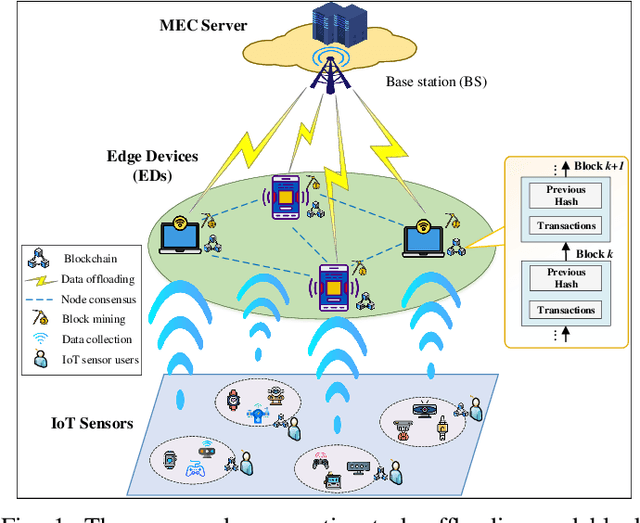
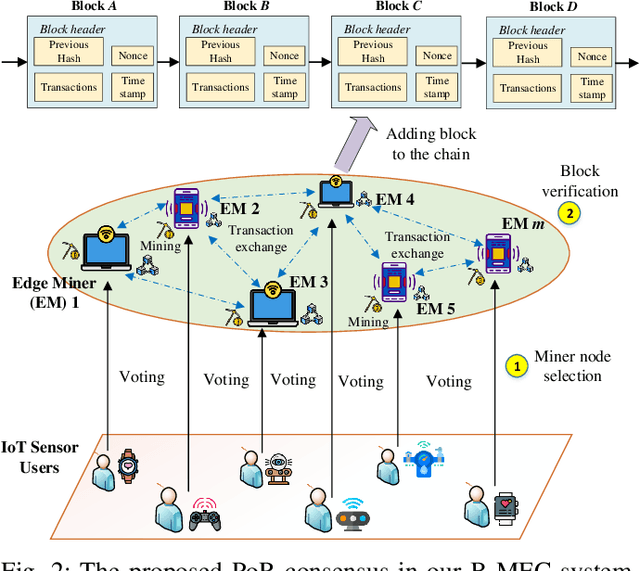
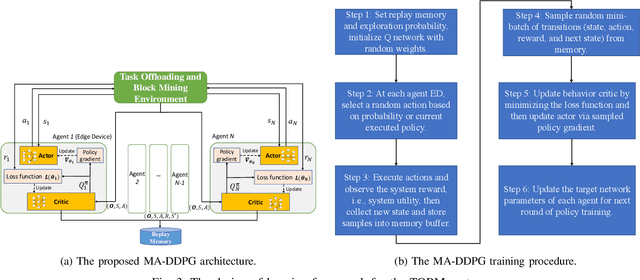

Abstract:The convergence of mobile edge computing (MEC) and blockchain is transforming the current computing services in wireless Internet-of-Things networks, by enabling task offloading with security enhancement based on blockchain mining. Yet the existing approaches for these enabling technologies are isolated, providing only tailored solutions for specific services and scenarios. To fill this gap, we propose a novel cooperative task offloading and blockchain mining (TOBM) scheme for a blockchain-based MEC system, where each edge device not only handles computation tasks but also deals with block mining for improving system utility. To address the latency issues caused by the blockchain operation in MEC, we develop a new Proof-of-Reputation consensus mechanism based on a lightweight block verification strategy. To accommodate the highly dynamic environment and high-dimensional system state space, we apply a novel distributed deep reinforcement learning-based approach by using a multi-agent deep deterministic policy gradient algorithm. Experimental results demonstrate the superior performance of the proposed TOBM scheme in terms of enhanced system reward, improved offloading utility with lower blockchain mining latency, and better system utility, compared to the existing cooperative and non-cooperative schemes. The paper concludes with key technical challenges and possible directions for future blockchain-based MEC research.
RIS-Assisted Visible Light Communication Systems: A Tutorial
Apr 14, 2022



Abstract:Recent development of the fifth-generation (5G) of cellular networks has led to their deployment worldwide. As part of the implementation, one of the challenges that must be addressed is the skip-zone problem, which occurs when objects obstruct the transmission of signals. A signal obstruction can significantly reduce the signal-to-noise ratio in radio frequency (RF) and indoor visible light communications (VLC) systems, whereas the obstruction can completely disrupt data transmission in free-space optical (FSO) systems. Therefore, the skip-zone dilemma must be resolved to ensure the efficient operation of 5G and beyond networks. In recent years, reconfigurable intelligent surfaces (RISs) that are more efficient than relays have become widely accepted as a method of mitigating skip-zones and providing reconfigurable radio environments. However, there have been limited studies on RISs for optical wireless communication (OWC) systems. This paper aims to provide a comprehensive tutorial on indoor VLC systems utilizing RISs technology. The article discusses the basics of VLC and RISs and reintroduces RISs for OWC systems, focusing on RIS-assisted indoor VLC systems. We also provide a comprehensive overview of optical RISs and examine the differences between optical RISs, RF-RISs, and optical relays. Furthermore, we discuss in detail how RISs can be used to overcome line-of-sight blockages and device orientation issue in VLC systems while revealing key challenges such as RIS element orientation design, RIS elements to access point/user assignment design, and RIS array positioning design problems that need to be studied. Moreover, we discuss and propose several research problems on integrating optical RISs with other emerging technologies and highlight other important research directions for RIS-assisted VLC systems.
6G Internet of Things: A Comprehensive Survey
Aug 11, 2021



Abstract:The sixth generation (6G) wireless communication networks are envisioned to revolutionize customer services and applications via the Internet of Things (IoT) towards a future of fully intelligent and autonomous systems. In this article, we explore the emerging opportunities brought by 6G technologies in IoT networks and applications, by conducting a holistic survey on the convergence of 6G and IoT. We first shed light on some of the most fundamental 6G technologies that are expected to empower future IoT networks, including edge intelligence, reconfigurable intelligent surfaces, space-air-ground-underwater communications, Terahertz communications, massive ultra-reliable and low-latency communications, and blockchain. Particularly, compared to the other related survey papers, we provide an in-depth discussion of the roles of 6G in a wide range of prospective IoT applications via five key domains, namely Healthcare Internet of Things, Vehicular Internet of Things and Autonomous Driving, Unmanned Aerial Vehicles, Satellite Internet of Things, and Industrial Internet of Things. Finally, we highlight interesting research challenges and point out potential directions to spur further research in this promising area.
Toward Blockchain for Edge-of-Things: A New Paradigm, Opportunities, and Future Directions
Apr 27, 2021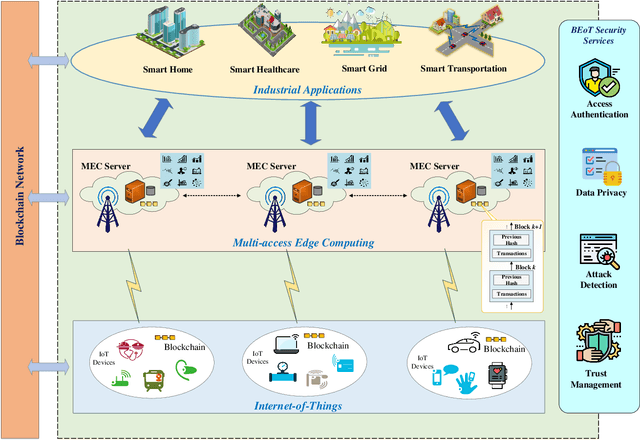


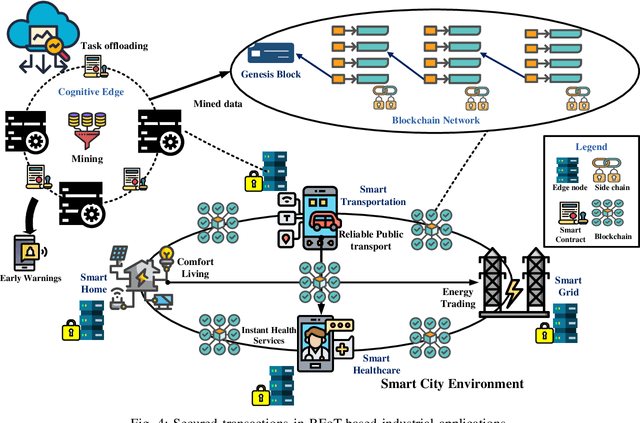
Abstract:Blockchain is gaining momentum as a promising technology for many application domains, one of them being the Edge-of- Things (EoT) that is enabled by the integration of edge computing and the Internet-of-Things (IoT). Particularly, the amalgamation of blockchain and EoT leads to a new paradigm, called blockchain enabled EoT (BEoT) that is crucial for enabling future low-latency and high-security services and applications. This article envisions a novel BEoT architecture for supporting industrial applications under the management of blockchain at the network edge in a wide range of IoT use cases such as smart home, smart healthcare, smart grid, and smart transportation. The potentials of BEoT in providing security services are also explored, including access authentication, data privacy preservation, attack detection, and trust management. Finally, we point out some key research challenges and future directions in this emerging area.
Application of NOMA in 6G Networks: Future Vision and Research Opportunities for Next Generation Multiple Access
Mar 03, 2021



Abstract:As a prominent member of the next generation multiple access (NGMA) family, non-orthogonal multiple access (NOMA) has been recognized as a promising multiple access candidate for the sixth-generation (6G) networks. This article focuses on applying NOMA in 6G networks, with an emphasis on proposing the so-called "One Basic Principle plus Four New" concept. Starting with the basic NOMA principle, the importance of successive interference cancellation (SIC) becomes evident. In particular, the advantages and drawbacks of both the channel state information based SIC and quality-of-service based SIC are discussed. Then, the application of NOMA to meet the new 6G performance requirements, especially for massive connectivity, is explored. Furthermore, the integration of NOMA with new physical layer techniques is considered, followed by introducing new application scenarios for NOMA towards 6G. Finally, the application of machine learning in NOMA networks is investigated, ushering in the machine learning empowered NGMA era.
 Add to Chrome
Add to Chrome Add to Firefox
Add to Firefox Add to Edge
Add to Edge